Tuesday, August 15, 2006
August 8
Our boat was huge. As big as a mall. It moved quickly with a steady, smooth rumbling. We shared a cabin with a group of other guys and had folded mattresses in stacks against the wall to unfold when we needed sleep.
Having misread our itinerary, I thought our six-hour trip would take at least 16, and was surprised to see land when I went out on deck to see if the deep sea really does smell different from coastal waters, as I had read in a book.
I spent my time on the boat talking to several Koreans, and got the impression that they are far more outgoing than the Japanese. One guy came up to me and wanted me to take his picture. I thought that was a strange request and he must have actually wanted me to take his picture, so I did. He actually hadn't misspoken, and wanted to take my picture, and for that, he brought me a beer and sat next to me and we talked for hours. He spoke English fluently and had been living in Japan the last several years.
Before we left the boat, we had several offers to stay at people's houses in Seoul and a slightly chunky guy with square half-rimmed glasses, who hadn't said much the whole way wanted us to follow him when we got off the boat. He told us he wanted to show us where to find cheap hotels, and we agreed to follow him.
Our ship was grand inside. Three stories of rooms, a spacious restaurant and open commons with cushioned chairs on each storey. There were rooms for Karaoke, beer vending machines, and a long deck where we could let the wind and mist blow through our hair and watch the sea go by. Through our binoculars, the horizon was speckled with small boats.
The ship was relaxing and pleasant. I found it much nicer than traveling by plane. We were not confined to a seat next to any particular person. The whole time, we could walk around, lie down to sleep, mingle, eat in the restaurant ... Customs was also much less invasive. No x-rays, rules about what you can have in your water bottle or extensive security procedures.
The ship moved so smoothly that I didn't even notice when it began to move, and could just see the golden dome of Fukuoka disappearing into the haze when I finally went outside to wait for the ship to depart. The ocean was a deep blue until we got to Pusan and it turned a coffee brown.
----------------
The hills around Pusan harbor just behind the docks and its huge red cranes are full of houses piled up on top of each other. Each one is a different color, has a flat roof, square windows, a blue container on the roof for water and almost no space between them. It looks almost like the Mediterranean, the colors are almost like Mexico. Our ship pulled deep into the bay with city and mountains on all three sides. Smaller boats went back and forth far beneath our deck and even larger boats sat like mountains blocking the coastline. It was a big, busy port full of containers and cranes.
With our backpacks on, we walked off the boat. Our new friend, Kwong, was telling us to follow him, we followed all the passengers into the quarantine to show our passports to Korean customs. We kept following Kwong, didn't have time to stop at Tourist Info and orient ourselves. We followed Kwong into the city, across a vast intersection with six lanes of impatient traffic. Across the street too big to have been in Japan, and down onto a neighborhood road too dirty to have been in Japan, with people standing around, talking, loitering, not as busy as people in Japan. This was definitely not Japan. We were hungry, our friend was asking around about where to eat.
Around a corner we brought our bikes up some nondescript, grey stairs into the entrance of a tall apartment building. "Lock your bikes", Kwong told us, asking if we thought they would be safe there, as if we knew better than he. Then, we went into an unmarked glass door with a red frame and found ourselves in a restaurant. A big menu hung on the wall, but we couldn't read anything but the prices.
Our food arrived sizzling loudly in thick, black stone bowls. Rice, spicy vegetables, Chile sauce and a dozen small plates of extras: Kimchi, Daikon, Chilies and other things I don't know the names of. The dish, we learned, is called Bibinbap. It's a good name, good food, and a spicy reminder that we had left Japan.
In Japan, everybody always pays for their own food. If you eat with a group, unless it is your principal taking you out on the mandatory end-of-semester lunches, restaurant tickets are always broken up. At my Conversation Night in Japan, I rounded up my tab by about ten yen and gave an even 500 to one of the ladies there. Two weeks later, she insisted that I take back my ten yen, saying that if you laugh at ten yen, ten yen will cause you problems later. I laughed and took it back.
In Korea, we were almost completely unable to pay for our own meals when we went out with other people. Kwong paid for our dinners and called his friend, Baek, who spoke excellent English and met us in the subway station. There, the team of two found us a room in the fanciest love hotel we've ever seen. It had internet, a wall-sized TV, a bath with full jacuzzi and a smaller TV built into the wall above it, a shower that doubled as a steam room, a huge bed, filtered water with a hot and cold tap and one of the fancy toilets I'd only seen in Japan with the console of buttons.
We thanked our new friends for their efforts, but that was not goodbye. Our itinerary for the evening also included drinks with the aspiring "dentalists". Our beer came in a 3 liter, mug-shaped pitcher and our table had sunken holes with cooling elements in them in which our personal beer caraffes fit and were kept icy.
Our boat was huge. As big as a mall. It moved quickly with a steady, smooth rumbling. We shared a cabin with a group of other guys and had folded mattresses in stacks against the wall to unfold when we needed sleep.
Having misread our itinerary, I thought our six-hour trip would take at least 16, and was surprised to see land when I went out on deck to see if the deep sea really does smell different from coastal waters, as I had read in a book.
I spent my time on the boat talking to several Koreans, and got the impression that they are far more outgoing than the Japanese. One guy came up to me and wanted me to take his picture. I thought that was a strange request and he must have actually wanted me to take his picture, so I did. He actually hadn't misspoken, and wanted to take my picture, and for that, he brought me a beer and sat next to me and we talked for hours. He spoke English fluently and had been living in Japan the last several years.
Before we left the boat, we had several offers to stay at people's houses in Seoul and a slightly chunky guy with square half-rimmed glasses, who hadn't said much the whole way wanted us to follow him when we got off the boat. He told us he wanted to show us where to find cheap hotels, and we agreed to follow him.
Our ship was grand inside. Three stories of rooms, a spacious restaurant and open commons with cushioned chairs on each storey. There were rooms for Karaoke, beer vending machines, and a long deck where we could let the wind and mist blow through our hair and watch the sea go by. Through our binoculars, the horizon was speckled with small boats.
The ship was relaxing and pleasant. I found it much nicer than traveling by plane. We were not confined to a seat next to any particular person. The whole time, we could walk around, lie down to sleep, mingle, eat in the restaurant ... Customs was also much less invasive. No x-rays, rules about what you can have in your water bottle or extensive security procedures.
The ship moved so smoothly that I didn't even notice when it began to move, and could just see the golden dome of Fukuoka disappearing into the haze when I finally went outside to wait for the ship to depart. The ocean was a deep blue until we got to Pusan and it turned a coffee brown.
----------------
The hills around Pusan harbor just behind the docks and its huge red cranes are full of houses piled up on top of each other. Each one is a different color, has a flat roof, square windows, a blue container on the roof for water and almost no space between them. It looks almost like the Mediterranean, the colors are almost like Mexico. Our ship pulled deep into the bay with city and mountains on all three sides. Smaller boats went back and forth far beneath our deck and even larger boats sat like mountains blocking the coastline. It was a big, busy port full of containers and cranes.
With our backpacks on, we walked off the boat. Our new friend, Kwong, was telling us to follow him, we followed all the passengers into the quarantine to show our passports to Korean customs. We kept following Kwong, didn't have time to stop at Tourist Info and orient ourselves. We followed Kwong into the city, across a vast intersection with six lanes of impatient traffic. Across the street too big to have been in Japan, and down onto a neighborhood road too dirty to have been in Japan, with people standing around, talking, loitering, not as busy as people in Japan. This was definitely not Japan. We were hungry, our friend was asking around about where to eat.
Around a corner we brought our bikes up some nondescript, grey stairs into the entrance of a tall apartment building. "Lock your bikes", Kwong told us, asking if we thought they would be safe there, as if we knew better than he. Then, we went into an unmarked glass door with a red frame and found ourselves in a restaurant. A big menu hung on the wall, but we couldn't read anything but the prices.
Our food arrived sizzling loudly in thick, black stone bowls. Rice, spicy vegetables, Chile sauce and a dozen small plates of extras: Kimchi, Daikon, Chilies and other things I don't know the names of. The dish, we learned, is called Bibinbap. It's a good name, good food, and a spicy reminder that we had left Japan.
In Japan, everybody always pays for their own food. If you eat with a group, unless it is your principal taking you out on the mandatory end-of-semester lunches, restaurant tickets are always broken up. At my Conversation Night in Japan, I rounded up my tab by about ten yen and gave an even 500 to one of the ladies there. Two weeks later, she insisted that I take back my ten yen, saying that if you laugh at ten yen, ten yen will cause you problems later. I laughed and took it back.
In Korea, we were almost completely unable to pay for our own meals when we went out with other people. Kwong paid for our dinners and called his friend, Baek, who spoke excellent English and met us in the subway station. There, the team of two found us a room in the fanciest love hotel we've ever seen. It had internet, a wall-sized TV, a bath with full jacuzzi and a smaller TV built into the wall above it, a shower that doubled as a steam room, a huge bed, filtered water with a hot and cold tap and one of the fancy toilets I'd only seen in Japan with the console of buttons.
We thanked our new friends for their efforts, but that was not goodbye. Our itinerary for the evening also included drinks with the aspiring "dentalists". Our beer came in a 3 liter, mug-shaped pitcher and our table had sunken holes with cooling elements in them in which our personal beer caraffes fit and were kept icy.
Here are a few photos from Korea!
Nightscape of Pusan from the window of our 18th story hostel window.
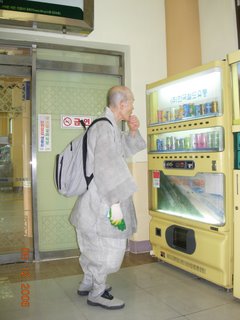

Nightscape of Pusan from the window of our 18th story hostel window.

 In the countryside, some towns are little more than a few highrise apartment buildings.
In the countryside, some towns are little more than a few highrise apartment buildings.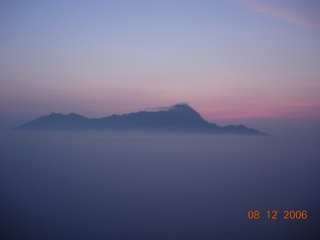
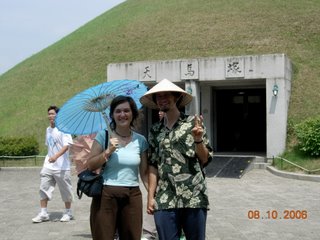
The last Korean Island we saw from the boat as the sun set.
Aja and I at the enterance to one of the tombs in Gyeong-Ju.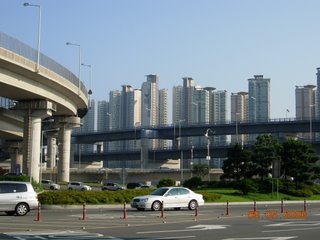
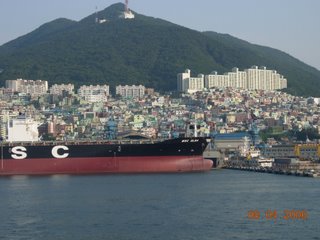
Our first sight of Korea in Pusan Harbor. View of Pusan's superhighways and mega- apartments
Monday, August 14, 2006

This is our new blog, started in China, to document our trip from Japan through mainland Asia. I hope that we can use this to keep in touch with all of our friends and family in far away places with our writing and pictures. To start with, this is mostly transcribed from journals we have been writing in most days. With this blog, we hope to improve our writing skills, and keep a memoir of our thoughts and experiences along the road through Asia. There is a lot we have already written and transcribing, editing and typing is a slow process, so it may be a little while before we are completely up to date. I hope you enjoy reading about our travels!
This blog is a bit of an experiment, and both of us are new to web pages. The layout is not exactly what we want, but maybe we can change that later. Hopefully, our web skills will improve quickly.
------------------------------------------------------------------------------------------------
August 3rd, 2006
We left Yamanashi from Isawa Onsen on the second train of the day after another night of smoke and alcohol at Kim's house. We listened to his new silly songs he is making into a record, and said goodbye to a few more of our Yamanashi friends.
In Fuji-Shi, we changed trains and rode each train until its final stop along the Tokaido line. We had a late lunch in Kobe, where we finally had our tickets checked. Near the station there was a big shrine with huge stone lanterns at its enterance. It enshrined one of Japan's great, benevolent, and locally loved warlords. Outside on the street the water meters were covered with the famous sights of Kobe drawn at off angles. It looked like it could only be a drawing of an earthquake.
Back on the platform, our bikes were still where we had left them in their bags to avoid hauling them through the station. This strategy works quite well, but maybe only in Japan. After fifteen hours of shifting through the trains, we finally made it to Hiroshima. It was late, my bike had a flat tire, and we settled for a hotel slightly out of our budget, the Hotel Intellegent.
The next day, we did some errands and visited the Peace Park. I saw the shell of the dome of the Industrial Promotion Building. It sits in a green lawn in a park full of trees. It has dark shadows and rough edges, red briks, grey cement, twisted metal, rubble left lying around it's edges. It is a ruin that has grown calm and peaceful over time. It is all that's left of the old Hiroshima.
A large American with a large camera, pink cheeks and round glasses wanted his picture taken in front of the dome. He made a serious face, but his camera malfunctioned. He told us it was ok for us to go on, and assured us he would be allright because he spoke some Japanese and could ask one of "them" to take his picture when he got it working again.
On Wednesday, we went to tthe Peace Memorial Museum. We dropped off the banner we made with AMC over a year ago with everyone's hands cut out and a message for peace written on each one. We made it intending to present it last year for the sixtieth anniversary of the dropping of the bomb, but didn't get a chance to. The museum gave us a cold reception. We were asked if we had an appointment, we didn't. Then, the lady who greeted us took our banner and told us she would deliver it to "him", whoever he was. She didn't ask our names or what it was, she didn't even thank us.
The museum started out slow, displaying scattered facts about Hiroshima's history and some pieces of documents relating to the selection of Hiroshima as a target, emphasizing Hiroshima's military history and importance. Overall, I was not as shocked by the museum as I had expected to be. A significant section in the first room was dedicated to "why Hiroshima was bombed", but only examined the military documents and deliberations about which intact cities would make good targets and good testing grounds and the criteria they used. It did not question the logic behind using the atomic bomb, or look deeply at the political motives; intimidating the Soviet Union and keeping it out of the occupation. It simply talked about the other cities that were considered and why Hiroshima was chosen. It does not completely accept that it had to happen, but the notion that it might not have been necessary is so subtile. In a sense, it seems to make an effort to justify it by reiterating how important Hiroshima was for the military because the fifth division and Pacific command were stationed there.
In the second half of the museum the focus shifted to people's stories. Burnt clothes , a metal lunch box with charred food in it , melted glasses ... all things people were wearing or had with them, and their personal stories. I was surprised at how poor the clothes looked. most had been patched together numerous times before they got burned.
There was a section on the health effects of radiation, pictures of the spots that form on ou head when you start bleeding internally, the strange swelling that takes over your body, bleeding gums, Leukemia ...
Finally, there were video interviews of people who survived, interviewed in the last ten years telling their stories, how they survived, how they suffered, how people helped them, the people they knew who died, and how they searched for their families. They told about the thoughts they had and what they went through. One old man was an elementary school teacher whose schoolhouse collapsed . When he and all the kids came out, other people were gathering there because it was a designated place to gather in an emergency. He thought only his school had been bombed, and was confused when he began noticing that all the people gathering were burned and injured. It was only then that he noticed that the whole city was gone. Another woman spoke, almost casually, about how her two kids and her husband died. She described how the buttons on her baby son's shirt were all that was left of his shirt and were still in place on his dead, charred body.
Today, Hiroshima is a rich city. It has wide sidewalks, well dressed people and expensive shops. The shell of the Industrial Promotion Hall is dwarved by the tall shiny new skyscrapers and wide roads. The old pictures of the city showed the proud dome with all of its skin still on, standing tall above the old tile-roofed city.
In Hiroshima, we went to the bank with unbrushed hair and wrinkled clothes to buy travellers checks to ease our minds while travelling. We hadn't thouroughly discussed what to do with all our money, and we were working it out when we got called up. We fully surprised ourselves with our new wealth as we pulled stacks of cash out of torn and scrbbled on envelopes and put down over a million Yen for checks to send home for safe keeping to use to start our new lives in New Zealand. The other half was set aside to be blown on our trip through Asia.
It was an exciting feeling. We could finally afford to travel, we have more money than we could have saved in Albuquerque set aside, and lots of time. Living in Japan without a car and with constant frugality let us leave rich. Our year in Japan had definitely bought us a considerable amount of freedom. Now we can head out with no worries!
After our first night in Hiroshima, we went to Miyajima on a ferry and passed by the famous giant red torii that stands in the water at high tide. It's a tiny island overcrowded with deer, shrines and with plenty of Okonomiyaki restaurants. Walking at night, the town was crawling with what looked at first like huge rats, but were strange animals I'd never seen before. They were Tanukis, or racoon-dogs. Funny little creatures with long legs and tails that, I think, only live in Japan.
We set up our tent at the campsite there for only 300 yen a night, and planned to stay for three, but a sudden rainstorm convinced us to miss the last ferry our on the third night and to stay in an internet cafe instead. Luckily, the rain missed Miyajima and all our things were still dry. A deer had eaten a hole in our tent, though. We packed up and left for Fukuoka.
Our last night in Japan.
We were meeting our friend, Rebecca, in Fukuoka. She wanted to go clubbing. We didn't, we had big bags and an early ferry to catch. We got there too late for clubbing and went to a street vendor selling beer and maybe some snacks. There are no street vendors in Yamanashi, but Fukuoka was full of them. We stayed there drinking and talking until I could barely stay awake. The street vendor who we didn't patronize helped us find another internet cafe. This one had showers, so we went for it. It also had a place for Aja to paint her nails, and enough room to fully lay down.